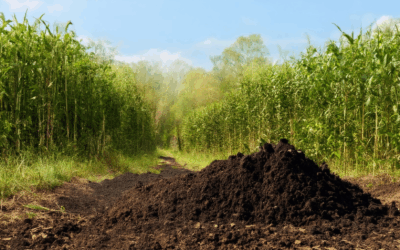In today’s rapidly evolving agricultural landscape, the pursuit of sustainable and efficient farming practices has never been more crucial. Among the most promising innovations is the adoption of zero-carbon farming technology, a groundbreaking approach that not only enhances productivity but also contributes positively to the environment. This cutting-edge technology offers farmers a unique opportunity to reduce their carbon footprint while simultaneously boosting crop yields and profit margins. By integrating innovative solutions, farmers can transition towards a more sustainable future, aligning with global efforts to combat climate change and promote eco-friendly practices.
Key Takeaways
- Boost Carbon Sequestration: Implement practices like agroforestry and cover cropping to effectively store carbon.
- Reduce Greenhouse Gas Emissions: Transition to renewable energy and low-emission technologies for sustainable farming.
- Enhance Soil Health: Improve soil fertility through techniques such as composting and reduced tillage.
- Optimize Resource Use with Precision Agriculture: Utilize GPS and drones to maximize efficiency and minimize waste.
- Adopt Vertical Farming: Save space and reduce emissions with high-tech indoor growing systems.
- Restore Land with Regenerative Farming: Rejuvenate degraded areas through holistic practices.
- Sequester Carbon with Biochar: Convert organic waste into a valuable soil amendment.
- Earn Carbon Credits: Access platforms like Carbon Farmer and Nori to monetize sustainable efforts.
- Leverage Native Grasses: Choose switchgrass, miscanthus, and others for effective carbon storage.
- Protect Soil with Cover Crops: Enhance soil health and carbon capture with annual cover crops.
- Sustain with Legumes: Improve nitrogen fixation and soil health using alfalfa, sunn hemp, and leucaena.
- Integrate Agroforestry: Combine trees and crops for enhanced carbon benefits and shade.
- Future-Proof Farming with Smart Greenhouses: Employ sensors, data analytics, and automation for efficient growth.
- Conserve Resources Smartly: Implement water and energy-efficient systems in greenhouses.
- Gain a Competitive Edge: Stay ahead with cutting-edge technology solutions from companies like AgriNet and CropX.

How to Make Money from Carbon Farming
Carbon farming offers several avenues for generating income, leveraging both the carbon market and sustainable agricultural practices. Here’s a structured approach:
- Sell Carbon Offsets :
- Participate in the voluntary carbon market by measuring and reporting carbon sequestration on your land. Certify your efforts through recognized programs like Verified Carbon Standard (VCS) or the American Carbon Registry (ACR).
- Government Incentives and Grants :
- Explore federal and state programs that offer subsidies or grants for adopting carbon farming practices. These may include tax credits or rebates for implementing sustainable techniques.
- Carbon Farming Services :
- Offer consulting services to other farmers or landowners on carbon farming methods. Develop educational workshops or online courses to share knowledge and expertise.
- Biochar Production :
- Produce biochar, a carbon-rich soil amendment, and sell it to local farmers or gardeners. Biochar not only improves soil health but also sequesters carbon.
- Participate in Carbon Projects :
- Join larger initiatives like reforestation or afforestation projects. These often come with funding and support to establish carbon-sequestering projects.
- Compliance and Certification :
- Obtain certifications or adhere to industry standards to enhance credibility and marketability. This ensures your carbon offsets meet the demands of serious buyers.
- Supply Chain Partnerships :
- Collaborate with businesses needing carbon offsets, acting as a local supplier. Build long-term relationships to secure consistent demand and favorable pricing.
- Branding and Marketing :
- Create a strong brand identity to attract buyers and partners. Consider joining cooperatives to leverage collective strength and resources.
- Stay Informed :
- Keep abreast of policy changes and market trends. Adapt strategies to respond to shifts in demand and regulatory requirements.
By combining these approaches, carbon farmers can diversify income streams, contribute to environmental goals, and build a sustainable future.
What is the zero carbon method?
The zero carbon method refers to achieving net-zero carbon emissions by balancing the release of carbon dioxide with its removal from the atmosphere. This approach aims to create a sustainable future by eliminating fossil fuel dependence and significantly reducing greenhouse gas emissions responsible for climate change.
Key Components of the Zero Carbon Method:
- Renewable Energy Transition : Shift from fossil fuels to renewable energy sources like solar, wind, and hydropower to reduce carbon emissions from electricity generation.
- Carbon Capture Technologies : Implement technologies to remove carbon dioxide from the atmosphere, such as carbon capture and storage (CCS) and biosequestration.
- Green Building Practices : Design and construct buildings with energy-efficient features, use renewable materials, and adopt strategies to minimize carbon emissions during construction.
- Transportation Electrification : Promote the adoption of electric vehicles (EVs), invest in public transportation infrastructure, and encourage active transportation options like biking and walking.
- Circular Economy and Waste Management : Reduce waste generation, increase recycling rates, and promote composting to minimize emissions from landfills and industrial processes.
- International Agreements and Policies : Support global initiatives like the Paris Agreement and advocate for national policies that accelerate the transition to a low-carbon economy.
- Community Engagement and Education : Launch awareness campaigns, workshops, and programs to educate individuals and communities about the importance of adopting zero carbon practices.
- Just Transition : Ensure that the shift to a zero carbon society is inclusive and equitable, providing support for vulnerable populations and creating jobs in the clean energy sector.
Why the Zero Carbon Method Matters:
Adopting the zero carbon method is essential for combating climate change and preserving the planet for future generations. By prioritizing sustainable practices and innovation, we can create a healthier environment and ensure long-term economic stability.
To learn more about how to implement the zero carbon method, visit Pyrolysium and explore our resources on sustainable living and eco-friendly technologies.

What Are the Negatives of Carbon Farming?
Carbon farming, while beneficial for the environment, does come with certain drawbacks. Here are some key negatives:
- Land Availability and Productivity : Carbon farming practices like agroforestry and cover cropping require specific land conditions, often leaving less land available for conventional agriculture. This can reduce overall crop yields and limit the productivity of farmed areas.
- High Costs : Implementing carbon farming techniques can be costly. Farmers may need to invest in tree planting, mulching, or specialized crops, which can strain budgets, particularly during economic downturns.
- Learning Curve and Adaptation : New practices require learning and adaptation. Without adequate training or support, farmers may face initial inefficiencies or struggles, potentially discouraging the adoption of these methods.
- Soil Health Challenges : While carbon farming aims to enhance soil health, factors like poor soil quality or limited water can hinder its effectiveness, leading to frustration for farmers who expect positive outcomes.
- Monitoring and Verification : Tracking carbon sequestration requires resources and expertise. Farmers may need to invest time in data collection, and there’s uncertainty regarding the long-term retention of stored carbon.
- Market Demand Issues : The success of carbon farming depends on market demand for carbon-sequestered products. Without consumer willingness to pay premiums or sufficient infrastructure for processing and verifying credits, efforts may not yield rewards.
Addressing these challenges requires supportive policies, education, and reliable markets to ensure carbon farming’s viability and widespread adoption.

What is Carbon-Smart Farming?
Carbon-smart farming is an agricultural approach focused on actively sequestering carbon and reducing greenhouse gas emissions associated with farming practices. This method integrates sustainable techniques to enhance carbon capture, mitigate climate change, and promote environmental stewardship.
Benefits of Carbon-Smart Farming
- Carbon Sequestration : Practices like agroforestry, afforestation, and cover cropping help store carbon in trees, soil, and vegetation.
- Reduced Emissions : Adoption of renewable energy sources, such as solar panels, and low-emission technologies lowers carbon footprints.
- Improved Soil Health : Techniques like crop rotation, composting, and reduced tillage enhance soil fertility and carbon storage capacity.
Key Technologies and Tools
- Precision Agriculture : Using GPS and drones to optimize resource use and minimize waste.
- Vertical Farming : High-tech indoor growing systems that use less land and emit fewer greenhouse gases.
- Regenerative Farming : Restoring degraded lands through practices like grassland restoration and holistic grazing.
- Biochar Production : Converting organic waste into biochar, a carbon-rich material that improves soil health and sequesters carbon.
Smart Solutions for Farmers
Farmers can leverage digital platforms like Carbon Farmer and Nori to track and sell carbon credits, enabling them to participate in carbon markets and receive rewards for their sustainable practices.
By adopting carbon-smart farming methods, farmers contribute to a healthier planet while enjoying economic benefits and improved resilience against climate challenges.
Best Crops for Carbon Farming
Carbon farming focuses on practices that enhance carbon sequestration, improving soil health, and promoting sustainable agriculture. While trees are often highlighted, several crops excel in this role due to their ability to sequester carbon, improve soil structure, and promote biodiversity.
Native Grasses
Native grasses are highly effective for carbon farming due to their deep root systems and adaptability to local environments. Examples include:
- Switchgrass
- Miscanthus
- Bermudagrass
- Bluegrass
These grasses are often used in perennial systems, where they continue to grow annually and contribute to long-term carbon storage.
Cover Crops
Cover crops are planted to protect soil, suppress weeds, and improve soil health. They play a significant role in carbon sequestration:
- Clover (Trifolium spp.)
- Rye Grass
- Vetch
- Oats
- Barley
These crops are typically annuals but provide substantial benefits to soil health and carbon capture over time.
Legumes
Legumes are known for their ability to fix nitrogen in the soil, which enhances fertility and supports plant growth. Some legume species used in carbon farming include:
- Alfalfa
- Sunn hemp
- Leucaena
- Vetch
These plants not only sequester carbon but also improve soil nutrient levels, making them a valuable addition to carbon farming systems.
Agroforestry
Integrating trees with crops is a practice that enhances carbon sequestration. Trees are planted alongside crops, providing additional carbon storage and shade benefits:
- Fruit Trees
- Nut Trees
- Shade Trees
This approach combines the benefits of both crops and trees, creating a more robust carbon farming system.
Organic Matter and Soil Health
Incorporating organic matter, such as compost and manure, significantly improves soil health and carbon storage capacity. Practices like crop rotation and intercropping further enhance these benefits.
By selecting the right crops and implementing sustainable practices, farmers can effectively contribute to carbon sequestration while maintaining productive agricultural systems. The combination of native grasses, cover crops, legumes, and agroforestry practices creates a holistic approach to carbon farming that benefits both the environment and agricultural productivity.

Smart Greenhouse Farming
A smart greenhouse farm integrates advanced technologies to optimize plant growth and resource efficiency. Unlike traditional greenhouses, which rely on manual adjustments, smart greenhouses employ sensors, data analytics, and automation to create ideal growing conditions.
Key Components of Smart Greenhouses
- Sensors: Monitor environmental factors like CO2 levels, soil moisture, pH, and temperature to ensure optimal plant health.
- IoT and Data Analytics: Collect and analyze data to adjust growing parameters such as light, temperature, and irrigation in real-time.
- Automated Systems: Control lighting, ventilation, and watering through programmable timers and algorithms.
- Water Conservation: Use sensors to detect soil moisture and adjust irrigation systems to minimize water usage.
- Energy Efficiency: Optimize heating, cooling, and lighting to reduce energy consumption.
Benefits of Smart Greenhouse Farming
- Increased Yields: Precise control leads to better crop production and quality.
- Reduced Costs: Efficient resource use lowers operational expenses.
- Sustainability: Minimizes environmental impact through optimized resource use.
- Proactive Monitoring: Predict potential issues and address them early to prevent losses.
Competitive Edge
Smart greenhouse farms leverage cutting-edge technology to stay competitive. Companies like AgriNet and CropX offer innovative solutions tailored for modern farming needs.
Conclusion
Adopting smart greenhouse farming practices empowers farmers to grow more efficiently, sustainably, and profitably. By embracing technology, they can unlock new possibilities and contribute to a more sustainable future.




0 Comments